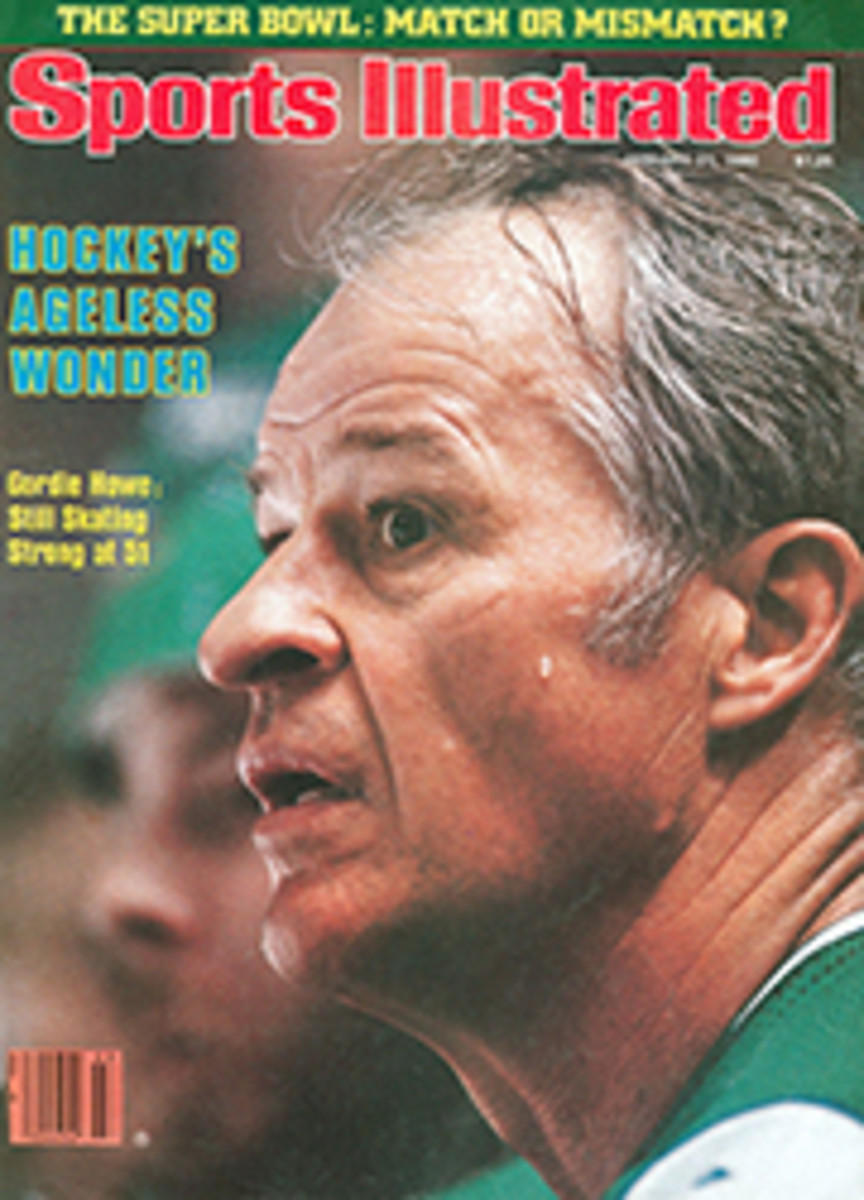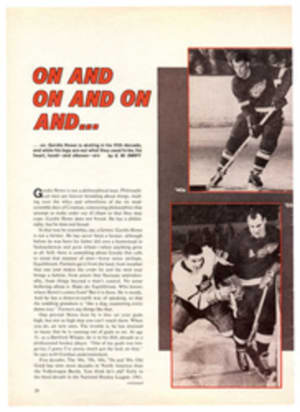
The beach boys on blades
Even in midwinter, the sun warms San Diego, yet inside the Mira Mesa House of Ice, just off Interstate 163, it feels more like Quebec than Southern California. Despite its name, which suggests that the building might house a wholesale ice-cube distributor, this dimly lit barn of a place is a skating rink, and home ice for United States International University's hockey team.
The very thought of college hockey in Beach Boys territory smacks of a publicity stunt, which isn't far from the truth. A small private school (enrollment 3,500, one-half of them graduate students) with many foreign students and branch campuses in London, Nairobi and Mexico City, USIU has image problems. "I've got an USIU decal on my car, and friends are always saying, 'But I thought you retired from the Navy,' " says one faculty member. USIU's doctoral program in behavioral sciences is nationally recognized, but most people, San Diegans included, had no clue what the school was until this winter when USIU rounded up a hockey schedule of big-name opponents—Harvard, Bowling Green, Ohio State, Denver—and began to distinguish itself by winning or splitting most series. This season USIU has a 16-8-2 record and is now being identified as "that school with the hockey team."
Hockey's emergence at USIU was almost an afterthought. A few years ago, hoping to counter the school's "foreign" reputation, USIU officials mounted an all-out campaign to attract more American students in the traditional ail-American way: athletics. Sid Gillman, the 68-year-old former head coach of the San Diego Chargers, was hired as athletic director last January to give credibility to what was then a dismal sports program.
USIU had begun playing hockey just before Gillman's arrival, mainly because of university president Dr. William Rust's longtime interest in the sport. In August of 1978, a Ph.D. candidate named Maynard Howe offered to organize a team in exchange for a graduate assistantship. Howe had played a bit of hockey and had coached briefly at the University of Maine before going west to study psychology. Begging favors from coaches he'd known, Howe patched together a schedule, spent all of three weeks recruiting in Canada and California and put a surprisingly solid team on ice. The Gulls finished the 1978-79 season 20-6-1. Howe then plunged into heavy recruiting for the current season, leaning on the most effective sales pitch for frostbitten Canadian players: sunshine.
"This is a great place to play hockey, no question about it," says Goaltender Paul Billing, who hails from Windsor, Ontario. Billing says he was "apprehensive" about USIU when first approached, wondering if California-style hockey could be for real, but the weather convinced him to give it a try. "You play hockey, and you've got the beach, the sun, the girls," he says. Sunny climes are the biggest lure for opponents, too. "It's our ace in the hole," says Al Palmiotto, who succeeded Gillman as athletic director when Gillman joined the Philadelphia Eagles last April. "For teams that play us, it's a nice little R&R in the middle of a Midwestern winter." And because other schools have no reason beyond getting suntanned to play in San Diego, USIU pays part or all of the opposition's expenses to the Coast, although total gate receipts from hockey games could barely cover a trip from San Diego to Disneyland.
Breaking even financially is an impossible dream for USIU teams. With no athletic facilities on campus except a soccer/football practice field, the school must rent outside space. The basketball team drills in San Diego Municipal Gym and plays in the 13,783-seat San Diego Sports Arena, often to the cheers of 600. The football Gulls compete in 52,596-seat San Diego Stadium, pulling in perhaps 1,000 paying customers a game, and hockey attendance at the 2,000-seat Mira Mesa meat locker ranges between 200 and 1,800.
Engaging in a long-term money-losing proposition—to the tune of several hundred thousand dollars a year—in hopes of going "big time" athletically is one route to recognition, but such expenses cannot help but drain a tiny private school. Still, coaches at USIU seem to operate on generous budgets. Who pays? Whispers abound that a pipeline of Iranian dollars backs the university, and there are rumors that a recently deceased well-heeled alumnus willed a few million to the school. Other speculation has it that USIU is someone's private tax deduction. But school administrators are closemouthed when queried on funding, admitting only that they are losing money and citing anonymous "backers" in the San Diego area. Howe, whose official title is Resource Development Liaison—"it means fund raising"—doesn't discuss cash flow. Rival coaches are also asking questions. "I can't figure out how USIU is funding its athletics," says one.
"You can tell that the hockey program is new," says Defenseman Andy Edur. "We'll run out of right-handed sticks, the skates won't be sharpened, or the ice will be awful. Little things. Like no towels in the locker room." Towels seem to be a continuing problem for the Gulls. "When we played there, we each got one towel the size of a washcloth, for game and personal use," says one Denver player. "Then they accused us of stealing them! For what, handkerchiefs?"
Towels and fiscal reticence aside, USIU's record has been impressive. "They've really been highly representative," says Denver Coach Marshall Johnston, whose team was beaten by the Gulls in October. "Maybe we underrated them," he adds. "The atmosphere there is so unlike hockey."
Denver was unfortunate enough to visit San Diego during a rainy spell, and the Pioneers discovered that USIU's rink, besides being dark and much too cold, has a leaky roof. "They had buckets to catch the drips all over the ice," says Johnston. "We had to skate around them." SKATE AT YOUR OWN RISK warns a sign near the snack bar. The boards are so battered and chipped that once when a puck was. hit out of play, it flew through a crack in a door to the bench. Spectators are shielded from the action by rusting chicken wire along one side, while both ends offer a few panes of pockmarked Plexiglas.
But Goalie Billing defends the rink, saying, "Teams come here and think we're a joke. A rink isn't a team. We've got talent and pride." Indeed, more than one catnapping team has been out-muscled by USIU. Three weeks ago, USIU beat Harvard twice, 7-2 and 8-3, and it recently swept a pair from Notre Dame, 5-1 and 7-3. "Everyone comes out here thinking it's a four-day vacation and two automatic wins," says Howe, "but they'll learn to take us seriously."
Teams visiting USIU do have trouble taking the school with a straight face. The campus, which is located on a hilly tract in northern San Diego County, is a high-priced chunk of real estate featuring eucalyptus, occasional snakes and dorms that resemble double-decker egg crates. The rink is four miles to the south, and those who do attend the games seem to be baffled about USIU's identity. At one recent game, two USIU rooters repeatedly yelled, "Come on American International!" That particular institution is in Springfield, Mass.
Howe's coaching philosophy might well turn Bobby Knight's stomach. He metes out no punishment to players who arrive late at practice or even skip it altogether, imposes no curfew and never chews out a player in front of his teammates. Howe's demeanor behind the bench is highly emotional, much like that of a Bible-thumping preacher. "My father was a minister, a very charismatic speaker," Howe says. "Maybe I think of myself in that way, too." He will sometimes cancel practice completely for a few days, as he did after the Notre Dame games. "I did that in Denver and some kids were upset," he says. "They all felt we needed practice, but I told them to take the time when we would have been skating and just sit and think about the game. That would help more than physically practicing."
Howe's opponents find such an approach puzzling. "Maybe there is some basis to what he's doing," Johnston says, "but most kids need practice in stickhandling and skating backward. Meditation may be all right, but you can't improve those skills by not practicing."
Howe continually refers to the maturity and responsibility of his charges, but Randy Moy, one of his assistant coaches, wonders about that, too. "Last week, I got a call at 10 p.m. from a couple of players who wanted me to pick them up at the airport," he says. "We shouldn't have to be baby-sitters. Maturity and responsibility? Wouldn't a mature, responsible person make his own arrangements to get home from the airport?"
Whether or not Howe sticks around—he talks of starting a hockey program at another California school—he has people talking about USIU, for sure. The Gulls are by no means a polished team, but they're winning against stiff competition.
So, for now, hockey is an I.D. card for USIU, the only school where players can celebrate the season's end with a beach party.
PHOTO
As Notre Dame (dark jerseys) discovered, the Ice House is primitive.
PHOTO
When Howe isn't coaching hockey, he is raising funds.

